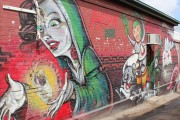I visited Peter Drew’s exhibition last weekend at A.P.Bond Gallery. Titled “All you need is LIKE” it is a very fascinating and thought-provoking assortment of work, combining Drew’s Studio pieces with his street art concepts in a single space. As with most abstracted work, there is a refreshing complexity associated with the broad concepts that Peter is exploring. He often looks at historic works of art and reworks them using a contemporary technique. In Drew’s pixelated work there is certainly an historic element; modernist works by Matisse and even the Australian landscape painter Hans Heysen has been reinterpreted. An art historian himself, Drew is no stranger to art appreciation.
 As you enter the exhibition space you are faced with an acrylic on canvas work; “Jules”, a colourful mix of pixilation and line. Jules was a previous housemate of Peter Drew and is also a street artist, known for his birds and fish around Adelaide. He always listened to music when in his studio, so the photo from which this work was derived shows his headphones around his neck. What is interesting about this work is that it uses line upon the pixelated squares to delineate form. It accentuates the human element to the form. The colours are balanced, harmonising with the repetition of shape. The thick white organic line contrasts with the sharp-edged blocky shapes. This duality of forms could also reflect a duality within the subject of the portrait.
As you enter the exhibition space you are faced with an acrylic on canvas work; “Jules”, a colourful mix of pixilation and line. Jules was a previous housemate of Peter Drew and is also a street artist, known for his birds and fish around Adelaide. He always listened to music when in his studio, so the photo from which this work was derived shows his headphones around his neck. What is interesting about this work is that it uses line upon the pixelated squares to delineate form. It accentuates the human element to the form. The colours are balanced, harmonising with the repetition of shape. The thick white organic line contrasts with the sharp-edged blocky shapes. This duality of forms could also reflect a duality within the subject of the portrait.
 Reinterpreting the work of other artists is a method by which one might understand their own work better. Peter Drew’s works often carry with them an historic lineage and by aligning himself with this history Drew injects his work with the vibrant sometimes lost ideals of old. With “Nude 2” there is a district reference to Matisse’s blue nudes. Matisse toward the end of his career carved with colour. Pure colour shapes, scissored out, became collaged together into perfect forms. Peter has echoed this bold application of colour with the body of his nude, in “matissian” blue; she sits upon the ground, clutching her legs thus modestly concealing her body. Her head and in particular her face however contains elements of Drew’s previous work- his signature “face” which can be seen throughout Adelaide streets is shown with its distinctive pick blushed cheeks.
Reinterpreting the work of other artists is a method by which one might understand their own work better. Peter Drew’s works often carry with them an historic lineage and by aligning himself with this history Drew injects his work with the vibrant sometimes lost ideals of old. With “Nude 2” there is a district reference to Matisse’s blue nudes. Matisse toward the end of his career carved with colour. Pure colour shapes, scissored out, became collaged together into perfect forms. Peter has echoed this bold application of colour with the body of his nude, in “matissian” blue; she sits upon the ground, clutching her legs thus modestly concealing her body. Her head and in particular her face however contains elements of Drew’s previous work- his signature “face” which can be seen throughout Adelaide streets is shown with its distinctive pick blushed cheeks.
 In a similar homage to modernist ideals; Drew has painted “Woman Ironing Out a Text Message”, which is influenced directly from Picasso’s painting “Woman Ironing”. To Drew this work conveyed the meditative qualities of everyday labour. Now though, what is considered everyday labour has changed considerably and consequently, Drew pokes fun at this aspect of our society by attaching a contemporary task to the title. Appropriately, through both of these works, Drew aligns himself with modernist ideals; as did the artists that created the originals. This is the most fascinating aspect of these art works for me. Modernism as a movement was concerned with the notion of the artist being the creative force. Inevitably it was through abstraction that the artist became free to truly examine the artistic elements. With good abstraction the “memory” of the object should still be evident in the work and Peter Drew does this with consummate skill. By using a contemporary form of abstraction he is also causing us to question our contemporary values; especially the ones involved with communication.
In a similar homage to modernist ideals; Drew has painted “Woman Ironing Out a Text Message”, which is influenced directly from Picasso’s painting “Woman Ironing”. To Drew this work conveyed the meditative qualities of everyday labour. Now though, what is considered everyday labour has changed considerably and consequently, Drew pokes fun at this aspect of our society by attaching a contemporary task to the title. Appropriately, through both of these works, Drew aligns himself with modernist ideals; as did the artists that created the originals. This is the most fascinating aspect of these art works for me. Modernism as a movement was concerned with the notion of the artist being the creative force. Inevitably it was through abstraction that the artist became free to truly examine the artistic elements. With good abstraction the “memory” of the object should still be evident in the work and Peter Drew does this with consummate skill. By using a contemporary form of abstraction he is also causing us to question our contemporary values; especially the ones involved with communication.
 As a person in their 40’s, pixilation drags my mind back to 80’s video games where technological constraints meant that digital imagery necessarily needed to be blocky. Detail in line and form was impossible. To see the true nature of the object we had to finish its construction ourselves. In Drew’s work we can perhaps see a warning; that, in a digital age whereby we are constantly flooded with images, the true nature of the object might be lost in perpetual abstraction. This is no more evident than in “first light in the clearing”. This work looks much like a tapestry containing numerous graduations of colour. Through the title I am engaged with the notion that it is a forest clearing with eucalyptus sapling stretching toward a hazy, warm, morning sky, the pure rays of sunlight just beginning to break through. The original inspiration for this work is still evident in this piece but like the morning it captures is obscured. “Mystic Morn”, 1904, by Hans Heysen is a favourite of Peter Drew. It is an ethereal landscape scene capturing the crisp morning light, breaking through the trees. In Drew’s interpretation; the form is still maintained, the is colour simplified, but the “memory” of the Heysen work is maintained.
As a person in their 40’s, pixilation drags my mind back to 80’s video games where technological constraints meant that digital imagery necessarily needed to be blocky. Detail in line and form was impossible. To see the true nature of the object we had to finish its construction ourselves. In Drew’s work we can perhaps see a warning; that, in a digital age whereby we are constantly flooded with images, the true nature of the object might be lost in perpetual abstraction. This is no more evident than in “first light in the clearing”. This work looks much like a tapestry containing numerous graduations of colour. Through the title I am engaged with the notion that it is a forest clearing with eucalyptus sapling stretching toward a hazy, warm, morning sky, the pure rays of sunlight just beginning to break through. The original inspiration for this work is still evident in this piece but like the morning it captures is obscured. “Mystic Morn”, 1904, by Hans Heysen is a favourite of Peter Drew. It is an ethereal landscape scene capturing the crisp morning light, breaking through the trees. In Drew’s interpretation; the form is still maintained, the is colour simplified, but the “memory” of the Heysen work is maintained.
There are of course many other works in this exhibition and it certainly takes the viewer on a journey to examine our own contemporary lifestyles and values. In this age it is something we all must do. Please visit this exhibition as it is only on until the 16th of June.


